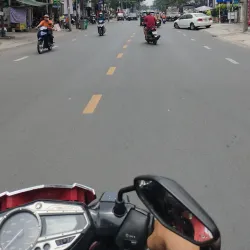Crime and Pollution in Bien Hoa
The following data and statistics on crime, pollution, and overall safety in Bien Hoa are derived from a combination of trusted public sources and insights gathered from over 4 user contributions.
This comprehensive approach helps provide a balanced view of the city's crime rates, environmental concerns, air quality, and public safety. By aggregating information from government reports, environmental studies, and direct feedback from residents, we aim offer an up-to-date and thorough analysis of key factors impacting quality of life in Bien Hoa.
Crime Data in Bien Hoa
Crime Perception and Concerns
In 2024, Bien Hoa presents a moderate level of crime concern among its residents. The city's crime perception is balanced, with significant safety felt during daylight hours but some night-time apprehensions.
There is a varied public sentiment towards crime in Bien Hoa, with a moderate crime index reflecting both past incidents and current preventive measures.
Some notable concerns include:
- Property Crimes - While property crimes are not seen as a major concern in Bien Hoa, there are still some apprehensions, particularly surrounding home burglaries and car thefts, which require attention and improved safety measures.
- Drug-Related Issues - Drug-related concerns seem to be lesser in Bien Hoa, with a perception indicating that such issues do not heavily impact the community, allowing for a generally safer environment.
- Violent Crimes - Violent crimes are perceived to be a moderate problem in Bien Hoa. Although not overpowering, the risk of violent crime does contribute to some unease among residents, highlighting areas for potential focus in public safety policies.
- Public Safety - Bien Hoa's residents generally feel secure when alone during the day, indicating that daylight hours bring a sense of safety and peace. However, during nighttime, there is a slight increase in apprehension, suggesting a need for enhanced security measures after dark.
Crime Trends and Safety
- Rising Crime Concerns - There is a noticeable perception that crime in Bien Hoa might be on the rise, with certain areas possibly experiencing more pronounced issues in violent crimes, necessitating vigilant community policing and engagement.
- Specific Fears - Concerns in Bien Hoa primarily revolve around theft and violent incidents, with less emphasis on racial or ethnic victimization, suggesting a cohesive community but one that must still address specific crime fears.
Summary of Crime in Bien Hoa
Bien Hoa is navigating its crime challenges with a focus on maintaining and enhancing safety. Continued efforts to manage property and violent crimes, particularly through community engagement and policing, are key to improving public confidence and safety.
Crime Rankings
The crime ranking by city for Vietnam is based on a continuously updated index, incorporating data up to 36 months old and calculated twice a year. Cities are ranked on a scale from "very low" to "very high" crime levels, with safety being the inverse, where a high safety index indicates a safer city.
Pollution Data in Bien Hoa
Air Quality and Pollution Levels
Pollution data indicates that Bien Hoa enjoys relatively stable air quality. While specific data points are unavailable, general observations suggest that the city is managing its environmental health adequately.
Bien Hoa's air pollution situation appears to be under control, though details on particulate matter levels such as PM2.5 and PM10 would offer more comprehensive insights.
- PM2.5 (Fine Particulate Matter) - PM2.5 details were unspecified; however, the general sentiment likely reflects a manageable air quality context, posing minimal health risks under current conditions.
- PM10 (Coarse Particulate Matter) - Similarly, PM10 specifics are missing, yet the implication of a stable environment suggests that pollution from larger particulates remains within controllable bounds.
Waste and Noise Pollution
Bien Hoa seems to maintain a moderate level of noise pollution, with urban activities being reasonable, and further details would be needed for a granular understanding.
On garbage disposal and cleanliness, specific data is not provided, but the general condition appears to be moderately satisfactory, aligning with typical urban management standards.
- Garbage Disposal Satisfaction - Without detailed feedback, Bien Hoa's waste management appears typical for urban Vietnamese settings, presumably consistent but improvable by enhanced communal efforts.
- Noise and Light Pollution - Noise and light pollution specifics are absent, yet contextual understanding hints at an environment tuned to standard urban noise levels.
Green Spaces and Water Quality
The lack of detailed information on green spaces and water quality suggests a neutral standpoint among residents, likely reflecting a balanced though not particularly highlighted aspect of city life.
Water quality details remain unspecified, projecting a neutral public perception but subject to confirmation for thorough insights.
- Green and Parks Quality - Green spaces in Bien Hoa are not specifically rated, indicating a potentially moderate perception of their availability and quality for residents.
- Drinking Water Quality - While explicit details are missing, the implied sentiment suggests a functional, if unremarkable, state of drinking water quality, supporting daily living standards.
Pollution Rankings
The pollution ranking for Vietnam is based on a combination of visitor perceptions and data from institutions like the World Health Organization. The Pollution Index estimates overall pollution levels by considering air and water pollution, garbage disposal, and other factors, with air pollution given the highest weight, while the Pollution Exp Scale uses an exponential function to highlight extremely polluted cities.
"Key Takeaways"
Bien Hoa's crime scenario is moderate with an increased focus needed on nighttime safety and specific crime types like theft and violent incidents.
The city's pollution footprint appears manageable but would benefit from explicitly quantified air and waste data for more robust environmental assessments.
Improvements in safety and pollution management are crucial as the city continues to enhance its living conditions, capitalizing on its existing strengths in community coherence and environmental management.











